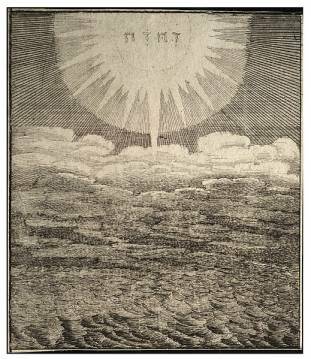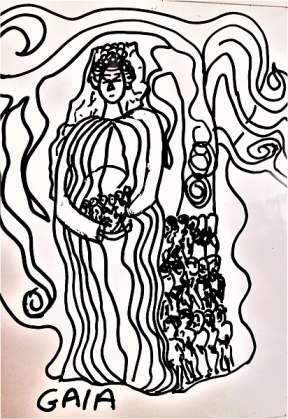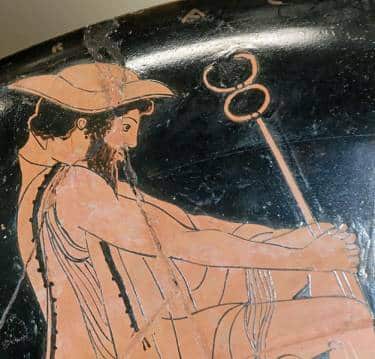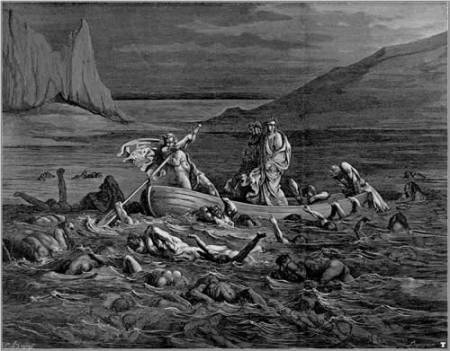Human beings have attempted to understand their existence and that of the universe since the 2nd millennium BCE. The earliest civilizations did this by using Creation myths to explain how the universe began.
The ancient Greeks were the first civilization to use the term cosmos when referring to their version of the universe as told in their creation myth.
In ancient Greek tradition, the cosmos is made up of three realms. They are the Sky and the Earth as well as the Underworld. Within each realm, there was a complicated mix of gods and goddesses, monsters and heroes, rivers, seas, forests, and more.
The Greek Creation Myth
There is more than one Greek creation myth which all center around a core group of deities. The most authoritative on the matter is the creation myth told by the ancient Greek Boeotian farmer, Hesiod. It has been dated to sometime in the latter part of the 8th Century BCE.
Hesiod claimed to have been given the information detailed in his poem from residents of the celestial realm, the Muses, The Divine Inspirations Behind Art, Science, and Culture. According to Hesiod in his genealogy of the gods titled, Theogony, before the beginning of time, there existed a yawning abyss called Chaos.

It was from this empty void that the first beings emerged. They are called primordial deities, as these early gods and goddesses were the personifications of the very basic aspects of the cosmos.
From Chaos emerged Gaia, the goddess of the Earth. Then after Gaia, out of the abyss came Tartarus, who was the personification of the lowest point of the universe. Next was Eros, the Greek God of love, and last was Erebus, the god of darkness, the personification of darkness.
These first beings then created other deities. Gaia created the Sky god Uranus, thus creating another realm. The ancients believed the Earth was a sphere that sliced the universe in half. Above her, the Sky, or Uranus, enveloped the Earth and was a solid dome.
Lastly, below the Earth was the Underworld, which was the realm of the dead. The lowest point of the universe was Tartarus, the gloomy dark pit, located in the Underworld.
Three Realms of the Ancient Greek Cosmos
The realms that made up the ancient Greek cosmos were the Sky, the Earth, and the Underworld. The Heavens were the space above the Earth where the gods lived. The Earth was where mortals, monsters and mythical creatures that personified nature as well as great heroes lived.
Each realm was composed of different sections. The Earth contained mountains, oceans, rivers, continents, and countries. The Underworld contained several different geographical areas, such as the Elysian Fields and Tartarus. The sky was divided into three sections, each with a different godly personification to represent it.
The Sky
In ancient Greek cosmologies, the heavens were held up and separated from the Earth by four pillars. These four pillars were believed to be Titan gods, who were the children of the primordial deities Gaia and Uranus.
First of the pillars was Coeus, The Intellectual Pillar of the Celestial North, the pillar of the north, and the Titan god of the inquisitive mind. Then came Hyperion, The Titan Illuminating, who represented the eastern pillar. Hyperion was the god of heavenly light. Next was the pillar of the west, Iapetus, the god credited with the creation of mortals. Lastly Crius (Krios), The Pillar of the South, who was the titan god of constellations, was the pillar of the south.
Mount Olympus
Within the celestial realm was Mount Olympus, the home of the Olympian gods and goddesses. It was said to exist above the clouds and the stars, in the bright pure upper air of the Earth’s atmosphere, known to the ancient Greeks as the Aether.
Homer describes this part of the celestial realm in great detail in the Iliad. The great palace of the King of the Gods, Zeus, was contained within the acropolis of the gods.
Homer describes Mount Olympus as an acropolis, a fortified palace complex, situated just below the summit of the mountain. The acropolis was said to be situated just below the solid dome of the sky.
To enter the acropolis and the palaces within, one would go through large golden gates. A mortal or creature could not simply let themselves in the palace complex of the gods. The gates were guarded by the goddesses of the seasons, the Horai.
The structures in the acropolis were built from stone and bronze and were surrounded by streets, golden pavements, and orchards. The courtyard in front of the grand palace of Zeus was where all of the gods of Olympus, and the deities who lived in the other realms would gather.
It was not just the twelve Olympian gods and goddesses who lived on Mount Olympus but the Muses, and the mythical winged horse, Pegasus, the winged horse lived in the realm too.
Creation of the Earth

The ancients believed the Earth was a goddess by the name of Gaia. Gaia was one of the first beings to emerge at the creation of the universe. Many different creatures, monsters, and heroes later came into being and lived on Earth. The Earth was home to many different beings, all personifications of vital parts of life such as the ecosystem, and rivers.
Who Lived on the Earth?
The Earth was home to mortals and several mythical deities. The minor deities known as Nymphs, Guardians of Nature. The nymphs were responsible for the piece of nature they personified, such as the clouds, trees, springs, and flowers.
They are associated with the Olympian gods and goddesses who tended to the fauna and flora of the realm, such as Demeter, Artemis, Dionysus, and Hermes.
The nymphs were not the only nature spirits to inhabit the realm, there were also the male nature deities called Satyrs. Satyrs were animalistic creatures that appeared to be half goat, half man. They lived in the remote forests and mountains of the realm.
The Earth was also home to the god Pan. Pan, like the Satyrs, The Half-Goat Demigod, was animalistic in his appearance. He had the hind legs and horns of a goat. He was the god of shepherds and herds, whose favorite pastime was pursuing the beautiful nymphs, to no avail.
Ancient Greek mythology is filled with interesting tribes who inhabited the wild, exotic, or unexplored regions of the realm. One such tribe was the half-horse, half-male tribe of the Centaurs, The Half-Human, Half-Horse Beings who lived in Thessaly and the Folio Oak Forest in Elis.
Another famed tribe was that of the Pygmies. They were a tribe of tiny African men, who were the same length as the distance between a man’s forearm from the elbow to the middle knuckle. The war-hungry tribe lived on the southern shore of the river Oceanus.
Many other creatures, monsters, and tribes found in ancient Greek mythology were said to live beyond Oceanus.
Gardens of Hesperides
In Greek mythology, the Hesperides are the nymphs of the west. These nature deities were also the nymphs of the golden light of sunsets and the evening. The Hesperides were believed to be the children of the Titan god Atlas, The Titan Who Held Up the Sky or the primordial goddess of night, Nyx.
Sources differ on the number of the nymphs, sometimes there are three sisters, sometimes seven. What the ancient myths do not vary on, however, is that the nymphs of the sunset were the guardians of the garden situated in the west of the earthly realm.
The garden of the Hesperides was situated close to the Atlas mountains in Africa on the edge of Oceanus. The serene garden belonged to the Queen of the Gods, Hera. The garden is an orchid containing a single gold-producing apple tree.
The apples were a wedding gift for Zeus and Hera from the primordial goddess of the Earth, Gaia, which Hera planted in her gardens. The golden apples were believed to grant anyone who ate one the gift of immortality. As such, these apples posessed much of the same qualities as the golden apples of the Norse goddess Idunn, which also granted immortality to the Norse gods who ate them.
Hera gave the task of protecting her golden apple tree to the nymphs. The queen of the gods was not the most trusting (perhaps due to her husband’s wandering eye), so she placed the immortal dragon Landon in the garden to keep watch over her golden apples.
It was from Hera’s orchid that the goddess of discord, Eris stole an apple which was the apple of discord. Eris used the apple of discord to cause a fight at a wedding which led to the Trojan War.
The Oceans, Lakes, and Rivers of Earth
The realm contained many vast seas, lakes, rivers, and bubbling streams. Each body of water on the Earth contained a god or goddess who was the personification of the water. Ultimately it was the Olympian god Poseidon, who ruled over the waters of Earth.
Poseidon lived in a sprawling palace made of gemstones and coral on the floor of the Aegean Sea. Poseidon was responsible for creating new islands, and earthquakes. He was also the creator and protector of the mythical lost island of Atlantis.
Poseidon’s son, Atlas was the king of the island of Atlantis. Poseidon destroyed the island with tremendous earthquakes that made it sink beneath the waves. The seas of ancient Greece were not just home to islands, they also housed several mythical monsters, spirits, gods, and goddesses.
There were the river gods known as the Potamoi, and their sisters, the Oceanids were the goddesses of the Earth’s freshwater, such as rain clouds, fountains, and springs. Ancient sailors had to navigate the seas extremely carefully, ensuring they steered clear of the many creatures who presided in the deep.
In the Strait of Messina, there lived two sea monsters, Charybdis and Scylla, The Sea Monster of Ancient Lore. Charybdis created whirlpools capable of destroying ships, and Scylla would pluck sailor’s from their ships to devour them. Scylla lived on the opposite side of the strait to Charybdis, The Whirlpool Monster.
Oceanus
In the ancient Greek cosmos, Oceanus was a River god, believed to be the river that encircled that sphere of the Earth, located at the ends of the Earth. This fresh-water river marked the boundary between the realms.
Beyond the earth-encircling river, was the edge of the cosmos. It is described as being a dark and misty shore where the solid bronze of the sky rested upon the dark sands. The river is believed to be situated near the Underworld and had to be crossed to enter the realm of the dead.
Oceanus was the source of all water in ancient Greece, providing the water to every stream, lake, and sea in ancient Greece. According to Homer and Hesiod, the river encircled the earth in a continuous loop. Hesiod describes Oceanus as the ‘perfect river.’ Not only did Oceanus mark the boundary between realms, but the ancients believed that the moon, stars, and sun all rose and set from his waters.
The Underworld
The Underworld is the realm situated below the Earth. Initially, Tartarus was the god and namesake of the realm below the Earth. Tartarus was a gloomy prison pit and the lowest point of the universe. Later Tartarus was absorbed into the Underworld, and instead became a section of the realm of the dead.
The ancients believed that when they died, they entered the realm of the Underworld. In ancient Greek tradition, when a person died, it was believed their soul, essence, or Psyche, The Deification Of The Human Soul immediately detached from their earthly body. The soul was transported to the Underworld by the messenger of the gods, Hermes.

The ruler of the Underworld was Hades. The Underworld was a complex realm composed of many different rivers and sections. The realm was said to exist at the edge of the cosmos, beneath the earth or the outer limits of Oceanus.
The dark realm existed without sunlight. Despite being a realm for the dead, shrouded in the dark mists of Erebus, the Underworld was home to many living features. The Underworld contains interesting flora such as asphodel flowers, sacred pomegranate trees, cypress trees, and white poplar trees. There are also meadows and rivers in the darkness.
There were said to be several hidden entrances to the Underworld in the earthly realm, but people usually found themselves standing on the banks of the river Styx where they would be taken into the Underworld.
Who Lived in the Underworld?
The Underworld was governed by Hades, meaning ‘unseen one’. When Zeus and the Olympians took power, the Heavens, Seas, and Underworld were divided between Zeus and his brothers, Poseidon and Hades.
Hades lived in the Underworld with his wife, Persephone, The Enigmatic Queen of the Underworld. Persephone was the daughter of Demeter and Zeus. The queen of the Underworld lived with her husband for only part of the year however.
Several gods and goddesses called the Underworld home. Notably, the primordial goddess of the night, Nyx and her children; Thanatos, the god of death, the personification of death as well as his his twin brother Hypnos who was the personification of sleep. Hypnos, the god of sleep lived in a cave where no light from the moon or sun could reach.
Other children of Nyx lived in the Underworld too, such as the Moroi or the Fates who controlled the destiny of all. The fates could be found close to the throne of Hades.
Hecate, the goddess of magic is another goddess who lived in the dark depths of the Underworld. Hecate was regarded as the goddess of witchcraft. The Furies, or Erinyes, The Goddesses of Revenge And Retribution as they were known, also resided in the Underworld.
The Furies were the three goddesses of vengeance, created from the drops of blood that fell to the Earth at the scene of the Titan Cronus’ castration. When someone had broken their oath the Furies would be invoked.
The Underworld was not just home to gods and goddesses, but many mythical monsters and creatures. The giant serpent Typhon, a monstrous serpentine giant, the father of all ancient Greek monsters, could be found in the depths of the Underworld.
Regions of the Underworld
Greek mythology has several different variations of where the different regions of the Underworld were, and what they looked like. It is generally accepted that the first part of the Underworld the shades saw was the banks of the river Styx or Acheron.
Once the newly deceased had been ferried across the River Styx (or the Acheron), by the Ferryman Charon, The Solemn Ferryman of the Underworld, they needed to be judged. Three sons of Zeus, Minos, Rhadamanthus, and Aeacus, were the judges of the dead. Sources differ as to where the souls of the dead were judged, with some mentioning the Plains of Judgment or the palace of Hades.
Once a soul had been judged, they would be taken by ferry to their final destination. If a soul was found to be pure, it would then be transported to the Elysian Fields or the Asphodel Meadows. If the person was wicked, a liar, a thief, or had hit a parent, their essence would be doomed to spend eternity being tortured in the prison pit.
The first region of the Underworld the shades would see was the Asphodel Meadows. As the shades made their way deeper into the Underworld, they saw two pools, one was connected to the river Lethe, and another was the pool of Mnemosyne or memory.
The majority of mortals would drink from the Lethe to remove the memories of their former life. However, those who had been initiated into the Ancient Greek mysteries would drink from the pool of memory.
Only the dead could enter the Underworld, and none were allowed to leave.
The Asphodel Meadows
The Asphodel Meadows are described as being a world of neutrality. There was nothing good or bad in the meadows, it was considered to be a rather boring place to spend eternity. It is where the average Joe of the ancient Greek world would find themselves living for all eternity.
Hades kept a herd of sable-black immortal cattle that would wander through the meadows.
In the Odyssey, Homer describes the Asphodel Meadows as being the region where the once great heroes wandered through the flowers, with the sound of ordinary souls flitting around them like bats.
Elysium
Elysium, often referred to as the Elysian Fields or Elysian Planes, was the paradise within the realm of the Underworld. Hesiod called Elysium the ‘Fortunate Isles. It was here the most distinguished members of ancient Greek society were believed to spend their eternal afterlife.
Ancient texts vary on where exactly Elysium was located. Hesiod places the Fortunate Isles in the world encircling the river Oceanus. Homer however describes Elysium as being a beautiful and peaceful meadow found within the Underworld.
The poet Pindar seemingly gives directions to the perfect afterlife, stating souls should follow Zeus’ road to the tower of Cronus. The Roman poet Virgil places the road to Elysium within the Underworld, situated at a crossroads with the first road leading to the pit, and the other towards Elysium.
Initially, only those who were related to the gods in some way, or the great heroes, were allowed to spend their afterlife in Elysium. In later stories, mortals who were chosen by the gods, or great heroes were allowed to enter the Elysian Fields.
Elysium is said to be the domain of the Titan Cronus. This version of the afterlife however was one without sorrow and hunger. Everything was provided to the souls lucky enough to find themselves on the Fortunate Isles.
Elysium is described as having fields of golden flowers, splendid trees, and streams with a soft breeze blowing from Oceanus, keeping all those on the isle cool. It never rained or snowed in Elysium, and all who lived there were happier than they ever were in life.
The Palace of Hades
The golden palace of Hades could be found in the shadowlands of Erebus. There Hades lived with his wife Persephone. Hades sat on a golden throne, where he watched as the newly deceased was judged by the three sons of Zeus. The court of Hades was always full of guests.
Adjacent to the king of the underworld’s palace was an orchard of sacred pomegranate trees.
Tartarus
Tartarus is the first realm to occupy the bottom of the universe believed to be guarded by a giant female dragon called Kampe. In the Theogony however, Tartarus is the misty prison pit created out of Chaos. Hesiod describes Tartarus as existing as far below the Underworld as the Earth is from the Heavens.
Tartarus is also the prison pit where the Titans were held by Zeus when he and his siblings deposed the Titan ruler of the cosmos (who also happened to be Zeus’ father). As the cosmologies evolved, Tartarus became a section of the Underworld, rather than a separate realm.
Tartarus is the deepest darkest section of the Underworld. The roots of the Earth are said to be visible above the suffocating darkness. This section of the Underworld is described in detail by Virgil, who details the various punishments witnessed by the hero.
Rivers of the Underworld
Among the meadows, fields of flowers, and torture pits, the Underworld contained five rivers that feature prominently in Greek mythology. Each river performed a vital function in the Underworld or was connected to a particular emotion. Each river met in the middle of the Underworld in the Stygian Marsh.
The Styx
Styx is perhaps the most famed of all of the rivers in the Underworld. The Styx, The Goddess of the Underworld River was believed to be the boundary between the realms of the Underworld and Earth. The Styx, just like Oceanus, encircled the Underworld seven times.
Styx in ancient Greek means hatred, the goddess of the river Styx, therefore, was the goddess of hate. The goddess Styx was the daughter of Oceanus and Tethys. The Styx is the river upon which all of the gods swore sacred oaths. Zeus would also use water from the river to settle disputes among the gods.
The Styx is regarded as the entrance to the Underworld. There the ferryman, Charon, would meet the newly deceased to ferry them across the river.
Charon however would only ferry the souls who had been buried correctly across the river. That meant they had to have been buried with a coin on their eyes or under their tongue. The coin was payment for the ferryman they would soon meet.
The ferry would pass through the famed gates of the underworld, which were guarded by the monstrous hellhound Cerberus.
The Acheron
Another river is Acheron, the river of misery that was a tributary of a swampy section of the Underworld known as the Acherousian lake. In some myths, it is the Acheron that Charon ferries the dead across, not the Styx.
Plato refers to the river as the place where souls wait to be returned to the mortal realm, later reborn as animals.
The Pyriphlegethon
The Pyriphlegethon was a river of blazing fire. The river wound its way deep into the Underworld to a section of the realm alight with the flames from ancient Greek funeral pyres.
This mythical river of fire was described by Plato, as the entrance to Tartarus, the most feared place in the domain of Hades.
It is thus quite fitting that the most wicked of ancient Greek society had to pass through an inferno before reaching their final destination. Plato referenced the river as being the source of volcanic eruptions.
The Cocytus
The Cocytus is the river of wailing. It fed into the river Acheron. In ancient Greek religion, if a person did not receive a proper burial, they were denied entry into the Underworld. The ferryman, Charon, would refuse to transport them when they arrived on the banks of the Styx; they were left to wander the banks of the Cocytus.
The Lethe
The Lethe represented forgetfulness or oblivion. When the essence of a mortal reached the Underworld they were made to drink from the river Lethe to forget the life they lived in the realm of the living. Lethe was also the goddess of forgetfulness and the daughter of Eris.
Once a soul had entered the Underworld and drank from the river Lethe to forget, they were never allowed to leave.
Featured Image Source: Wikimedia Commons

